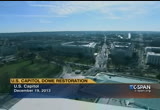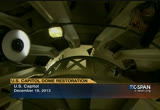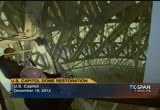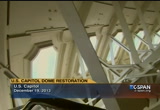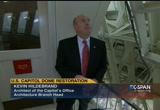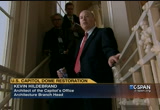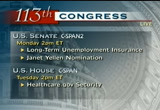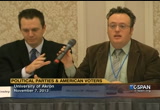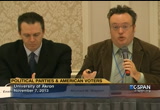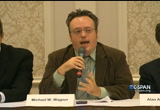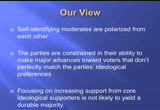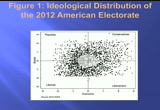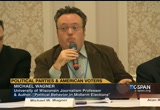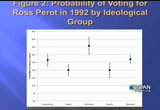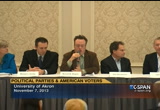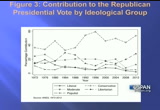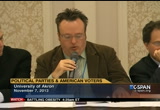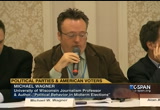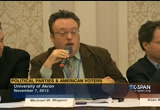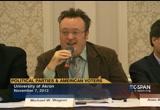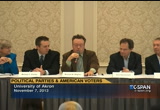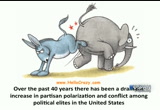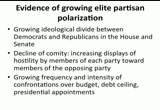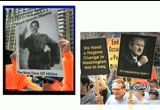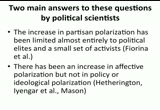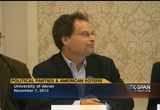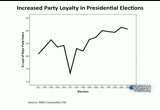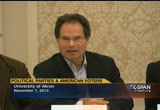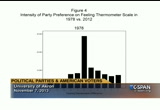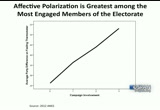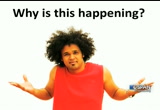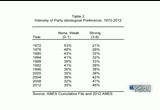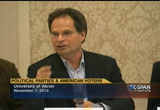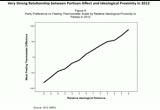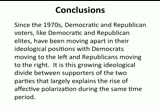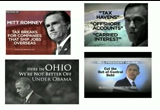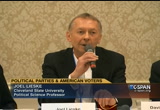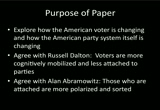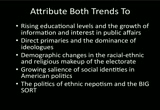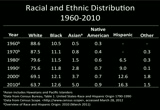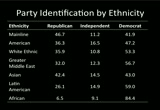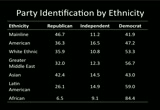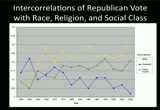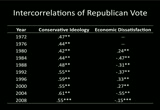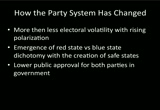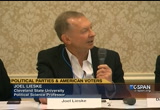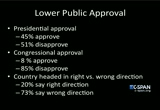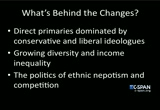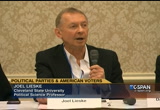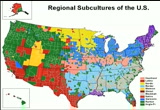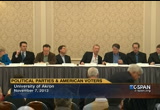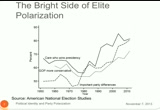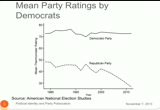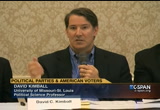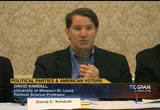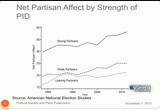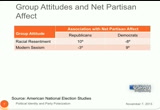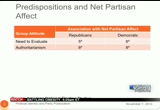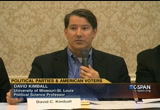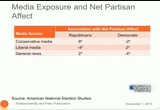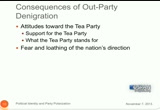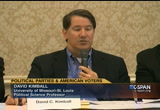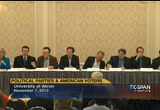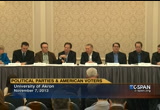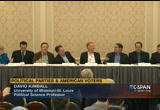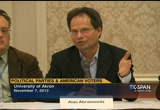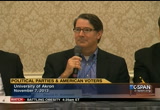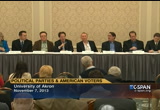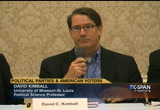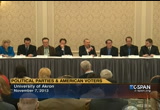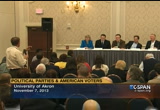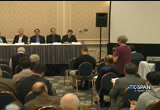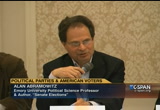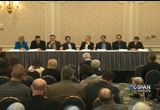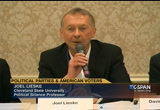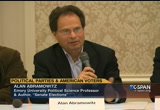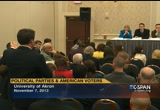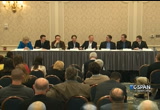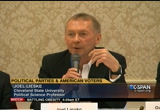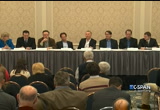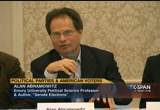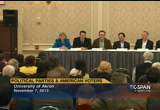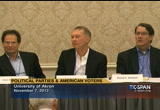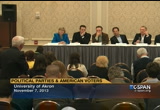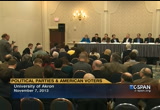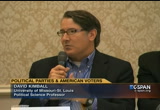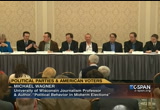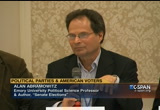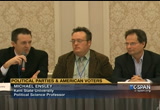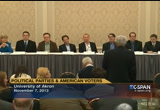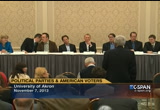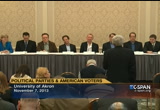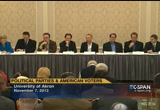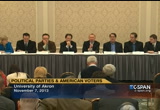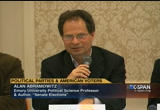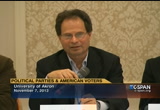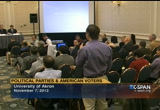tv Parties-- Voters CSPAN January 6, 2014 12:25am-2:25am EST
12:25 am
would give you a sense of that. i can tell you that i removed >> 180,000 pounds of lead based paint from the attic during our first phase so i know it shouldn't weigh more than the amount of lead paint already taken off. just as when you came out watch your head as you come through this doorway. >> that is the convene light that is on at night when the congress is in session, the convene light. it is four bulbs. there is another interstitial space that is a hollow cavity below the statue base then the statue above that. as you see, no person is permitted above this platform under any circumstances.
12:26 am
just make sure there is someone in front of you. if there is somebody you can focus on it is easier. >> how far are we going down? >> we will stop here. one of the things i wanted to point out to you here coming down the steps you will see that the 36 rib trusses that form the superstructure of the dome converge here to the 12 that go up to support the statue of freedom. as you can imagine, trying to merge 36 items into such a small space at the top was too great so every third truss is the one that continues forward and the two that flank it merge into its side for buttressing support.
12:27 am
what you also see is the enormous super structure has very slender bands that reach down to suspend the shell below. and it has a very thin element that reaches out to the shape of the exterior dome. the brilliant thing about this design is that the dome is exposed to very harsh conditions on the outside, very cold in the winter, extremely hot in the summer under direct sun. some plates may approach 130 degrees fahrenheit. but because they are held away from the super structure that heat dissipates in the iron work before it gets to the super structure so the relationship trusses see very little temperature swing during the course of a year which helps to maintain the structural integrity of the dome. it does not move that much. but a lot of the damage that we are addressing is in the shells and they are exposed to wide
12:28 am
temperature swings, a lot of expansion and when the rust develops between the plates in binds the plates from moving and creates enormous pressure in the iron work which relieves itself by cracking. most of the work we will be doing in this case -- in this space will be addressing cracks in the exterior shell. as a huge erector pieces come interesting a foundry they had to mark each pace so they knew at what level of the dome each piece was to go so don't be surprised if you see these marks on every piece as you go down. there was a clear pattern made for each location and it was important it go in at a certain spot and they used the marks to make sure the installers knew where to place it. you will remember in the opening remarks they talked about the acorn finial that had cracked and had to be removed. you will notice there are a series of bolts that go through
12:29 am
the plate above the octagonal window there. is a large ornamental piece that crests that window that. is where the acorn finial is from. >> [inaudible]? >> the crack? >> [inaudible]. >> all of that will be preserved. our goal is to keep as much of the historic fabric as possible. >> [inaudible]? >> it will be repaired, yes. >> there will be 12 of these outriggers that go out into the rotunda that support the netting system that is suspended above the floor. >> from the rendering you couldn't tell. is it a net or plastic? >> a multilayered netting that is meant to capture a load of
12:30 am
500 pounds and more and so we start with a very large net and a layer of slightly smaller netting then a very tight net to catch any small objects. all of that is concealed by a decorative scrim that creates the image of the canopy that you saw in the briefing. >> is there a worry that hammering will shake something loose? >> if a nut were to fall or if there was a broken piece of iron. we want the belt and suspenders safety to protect the public and make sure there is ample construction barriers there to preclude anything from happening. not that we are expecting it to happen but we want to ensure that it doesn't. everything, the bracket, the columns and the super structure behind the skin politics was
12:31 am
was createdplates in a foundry in baltimore called cool and hunt. once pool and hunt had finished their work up to the balcony from that point forward all of the work was done by james fowler kirkland out of new york. the wires are part of a defunct bird proofing system. we will remove them and install a passive netting system to keep smaller birds from nesting. when we started this project, there was a major water event in the fall of 1990 that deposited a large amount of water on the floor of the rotunda. it is through your investigations that we discovered bird nesting materials and eating on the dome is what clogged the system and caused the water to back up and cascade national rotunda.
12:32 am
we have taken on a series of projects since that time to ensure that the drainage system is never compromised again by debris. and it led to though the development of the master plan and study of the iron work and to the project we are now going to get completed in the next two years. [captioning performed by national captioning institute] [captions copyright national cable satellite corp. 2014] >> we will have prime minister's questions live wednesday 7:00 a.m. >> they will also continue debate on the nomination of janet yellen to be the federal reserve chair. you can follow the senate live on c-span two. the house returns tuesday at two eastern for a pro forma session, they will recess until 6:30.
12:33 am
they will mark the start of the second session of the 113th congress. later in the week, the house plans to vote on two bills related to the federal health care law, one to monitor its implementation and the other to protect personal information on the website. live health coverage on c-span. -- live house coverage on c- span. >> the deadlines approaching for the video competition open to high school students. there is $100,000 in total prizes, with the grand prize of $5,000. these are due by january 20. get more info at student cam.org. >> university of akron recently hosted its annual state of the parties conference. next, one of the discussions from the event, it focuses on
12:34 am
the changing electorate as well as some of the factors that have created divisions between the two parties. this is two hours. a much, john. thank you for having me. i am very excited about this panel. my primary job is to keep everybody in their time limits, but i am sure that -- i have read all their papers, there really interesting. i'm looking forward to the next couple of hours. we will start with to my immediate left, there are three authors on this paper. with us michael ensley of kent state university and michael wagner of the university of wisconsin. gentlemen, i will let you take it from there. >> good morning, everybody. we are delighted to be here and thank john green for assembling a great panel and meeting. we thank janet for doing all she
12:35 am
did to help us get here and help us get a home when we are done. i guess to help the c-span ,udience feel more comfortable we can hold a 21 hour filibuster and talk until the meeting is over. our paper is part of an ongoing carmine, mikeed ensley and i have been working how the waywith american public opinion is reacts to the way the elites structure their preferences. as we begin thinking about what we want to talk about today and the state of the political parties and the future of political parties, we begin looking at some contemporary from "the newes york times." about three years ago in october
12:36 am
of 2010, tom friedman wrote a column where he wrote, quoted there is going to be a serious third-party candidate in 2012 with a movement behind him are her, one definitely big enough to impact elections outcome. he followed up and said that the former comptroller david walker might he such a candidate. the lack of president walker aside, -- and on the other side aisle, thelogical day after the column appeared making the argument that the obama realignment might not last the on the next presidential election, which doesn't make it much of a realignment. what strikes us about the way that these folks are thinking about american political parties is that the expectation is for major durables sustained dramatic change.
12:37 am
the argument we want to make is that people who are looking for that kind of change are going to be waiting a while. what we want to do today is try to make three empirical points that come from a theoretical perspective. the first is that self identifying moderates are polarized from each other. this makes it for difficult for a centrist party to rise and be a viable third party in the united states. -- second and finally, the argument we ant to make is that --
12:38 am
begine our argument, we with evidence from poole and , that congressional elites are reliably divided along a single ideological dimension, a left/right dimension. it dominates our elected republicans and democrats cast their votes when they are behaving in congress. is not so similarly divided, but divided along to principal dimensions, one an economic dimension dealing with the way that government spending and regulation is understood and one dealing with social issues, dealing with questions of moral right and wrong. both of these dimensions have a left-right dimension to them but they don't perfectly overlap. the consequence here are the fundamental question we are interested in is what are the
12:39 am
consequences in a political system when it leaves divided along one dimension and the public divided among two. the research we are put together and the book we are wrapping up as he argument that some folks have orthodox preferences. these are people who are either liberal or conservative on both issues. these are people who behave as though there divided along a left-right dimension as members of congress are. these are folks that are polarized partisans, stable parsons, they make their vote choice really early, and engage more cynically, they consume partisan media, they don't split their tickets when they vote. a slightly larger group of voters have heterodox preferences, which is to say they might be liberal on one set of issues and conservative on another set of issues. folks who are conservative economically liberal socially might libertarian, folks who are
12:40 am
conservative socially but liberal economically might be considered populist, and those who are honest-to-goodness in the middle might be considered moderate. we make the argument that the heterodox voters participate less him are more unstable and the partisanship, flop back and forth between the parties, don't consume partisan media and split their tickets at a much higher rate when they vote. so to give you a sense of what this looks like, this is the 2012 american national election study. every dot is a person. on the x-axis are economic issues. the y axis is the social dimension. so liberals and conservatives in the lower left-hand and upper corners of this
12:41 am
figure are polarized. user becoming increasingly divided in the american electorate. these are the folks are more likely to anticipate. voterstrivial size of are libertarian and populist in their view. it is a fair amount of people who are in the middle with their preferences. what is interesting about the populists, libertarians and moderates is that they are all systematically likely to call themselves moderate when asked to place himself on an ideological scale. if you are very conservative economically and very liberal socially, you are a moderate, and if you're just the opposite, you are a moderate. that makes it very difficult for a third-party candidate to corral both of these groups of voters, since they disagree with each other and are as polarized as liberals and conservatives. we argue it will be very difficult for third to appeal to these voters who are quite different from each other, as
12:42 am
different as ideological liberals and conservatives. to give a sense of how this might try to operate, we went back in the study to 1992 when fairlyrot ran as a successful third-party candidate, getting about 19% of the popular vote, coming in second in maine and utah in the , in our and looking at five ideological groups, where did you rose support come from. did perot support come from? we have conservatives voting and the likelihood of 27% for ross perot. libertarians over 35% and moderates a little over 25%.
12:43 am
ross perot ran as a pro-choice but no economic regulation candidate, a libertarian set of issue positions and not surprisingly the libertarian voters were the most likely to support ross perot. on the other hand, he was giving these voters exactly what they wanted in general from a policy perspective and yet their likelihood that a libertarian would cast a vote for him was only 35%. even in the group that matched the independent candidate rest, when he was matching preferences the likelihood of a vote was not so high, speaking to the dominance of the party system in american politics. we think that the freedman argument about the radical center is one we should not worry about too much. -- this leaves parties with a couple different options. how do we sustain a durable majority over the long haul? you can imagine the parties might say to themselves what we folkso do is appeal to who are not in our core but have
12:44 am
a set of issues where they see things our way. formula papern a from robert axelrod that tried to estimate how much support candidates get from particular groups, how large the group is, how loyal they are and how much they turn out. those are the key elements of axelrod's formula. we apply the same formula to our ideological groups. this figure is showing you the percentage of contribution to the vote total for republicans in this case from 1972-2012. not surprisingly, conservatives provide the lion's share of support and since 1992 have really jumped up in the amount of support they provide for their voters. where else can conservatives go -- or republicans, that is, to try to increase their share of the rest of the electorate to
12:45 am
become a durable majority? in the interest of time, the short answer for the short term is libertarians. in the last two elections, they have been a larger part of the republican coalition. they turn out at a higher rate than do popular it's -- then do populists and moderates. they're a little more likely to support the republican party. that is the place where a republicans ought to consider trying to grab votes. even though we have a two- dimensional structure, the economic issues correlate most highly with peoples self- reported ideology and also are correlated more highly with peoples vote choice. conservatives match libertarians on economic issues and that is perhaps not so surprising. give the thing to note is that if conservatives have a hard time going after these is not aans,
12:46 am
consistent group and not a very large group. think,ublicans might let's just try to grow our core supporters. the reason we didn't win as we were conservative enough. if we can be more conservative and grow our core supporters then maybe we can win an election. but as the analysis we present in a hard to read table i will turnout among conservatives as articles to 80% and in 2012, 86% of the conservative vote went to romney. there's not a whole lot of room for them to grow the conservative vote. the republican party party makes the choice to go after conservatives and will not increase their margins very much. moving to democrats, the first thing to notice is that liberals not surprisingly make up the largest share of democratic presidential vote choice from
12:47 am
1972-2012. really quickly, on the republican side, the scale is up to 60%, here the scale is only up to 50%, so liberals make up a smaller portion of the democrats overall coalition then conservatives make up for the republicans coalition, which is something the democrats need to keep in mind. likeals are already conservatives with a relatively high turnout group in 2012, 95% voted for brock obama and so the democrats are not growing their coalition by appealing to the last five percent of liberals to push them over a 50% majority for the top. libertarians are more likely to identify or vote with your can moderates seem to be the best option for democrats to make their case in the future if they try to appeal to different
12:48 am
kinds of voters. in the last couple of elections moderates have been more likely to favor democrats. if i can find in my notes the exact numbers -- can i do it? in five of the last six elections, moderates have given the majority of the votes to democrats. it was 71% in 2012. immigrants have done a more successful job of solidifying moderate support, whereas the is true for republicans in terms of libertarian voters. neither of the strategies get .ither party above 50% given the way that these numbers fluctuate, especially with the -- it is aroups, very difficult argument, special
12:49 am
this0% voter turnout coming from conservatives for republicans or 95% from liberals. if you are abandoning some of the policy positions of your core group, you're risking alienating some of those folks. the parties are in a top position. two they go after these heterodox voters in a systematic way? and not to make a majority, but if they don't they can't rely on their core supporters to make a durable majority in the future. our conclusion is that we find the state of the parties are highly polarized at the elite level, polarized under some conditions at the mass level and that leaves parties in our view a small sea of uncertainty for the future. it is a good point to stop. -- lan i want to thank john and the
12:50 am
institute and the staff here for organizing this meeting and for inviting us here third thank you all for coming. to talk today about a phenomenon i found very interesting in recent american electoral politics and that is polarization. in this case the rise of what i call dollarization of the american electorate. i'm going to start off with a stylized facts. actually, i am going to talk about something i think is really happening in american politics. -- thati would hollow would fall under the heading of stylized fact. there has been an increase in partisan polarization in the
12:51 am
last 30 or 40 years. work't think i need to really hard to convince you that is the case. just in case you are sitting there thinking i'm not so sure about that, a few things we have seen that show that this trend is happening at the elite level are the growing ideological divide between parties in congress. we have seen lots of evidence of that. -- decline of, the the kind of language that is used on the floor and also when our political leaders talk in any forum these days. and perhaps most importantly the growing frequency and intensity of confrontations over budget, and debt ceiling, and presidential appointments that have been going on, most recently with the shutdown and
12:52 am
the debt ceiling crisis we had last month. lots of evidence of that. the question is what about the public? evidence there is some of growing intensity of partisan preferences and partisan conflict. the kind of people who showed up for tea party demonstrations, comparing barack obama to osama of laden, comparisons presidents with osama bin laden actually did start with obama, we saw this when bush was in the white house as well. hitler aresons with not just obama, but bush was compared with hitler. when i present the picture on the right, some of my democratic responsend colleagues is -- yes, that is true.
12:53 am
people are turning out of demonstrating, what we would like to know is hazarded been increase in partisan polarization in american public? if so, what explains the party divides? we have seen a couple different answers in the literature of political science. publicbasically that the is not more divided, that polarization has not increased significantly in the public. this is an elite phenomenon. the other interesting approach is been offered by some scholars is that there has been an increase in affect of polarization. people's feelings about the parties have become more divided. that doesn't mean the public is
12:54 am
more divided along policy or ideological lines the way leads are. i want to take a look at that as well. spoiler alert, i'm going to tell you what my findings are going to be. if you don't want to be surprised later, you will have to close your eyes and cover your ears. what i'm going to argue is that there has been a substantial increase in effective polarization in american electorate since the 1970s. one interesting aspect is that is been due to increasingly negative opinions by the parties of the opposing party. can be explained by an increase in policy and ideological polarization. closely connected with each other. they are not two different things. here is a puzzle. hand, if we look at
12:55 am
party identification and tracking over time, measuring go strength of party id, back to 1970s is pretty stable. we don't see much evidence of artie identification itself is becoming stronger in american electorate. , party loyaltynd is increasing. even though party identification is not getting stronger, we're seeing more party loyalty in voting. the seems to conflict with finding. nursing a big increase in party loyalty in voting. 1972 was an amazing year because over 40% of democrats voted for nixon. the recent data is quite striking.
12:56 am
2012, i am only using face- to-face interviews. in this presentation i rooted the internet-based portion. if you use that is even higher. but there are some differences between the results and the two employment. levels of party loyalty in voting in 2012. we also see big decline in ticket splitting since 1970s and in 2012 we had the lowest rate of ticket splitting in the of measuring voter behavior. their.w ticket splitting so what is going on? how to solve this puzzle? i'm going to suggest the answer could come from looking at this
12:57 am
other measure of the strength of party ties in the electorate area at is affect of polarization. over the last 30 plus years there has been a pretty big increase in the divide between the parties and the average difference between the rating of the two parties on the scale. earlier,mentioning that is all most entirely due to more negative rating of the opposing party. if you track this over time, the average rating of their own party has been pretty stable, around 70 degrees on the scale. that we increasingly dislike the opposing party. we give the other party a more negative rating. that is why that divide is opening up. just to show you, this does make a big difference in the distribution on that scale. this is what the distribution looked like in 1978.
12:58 am
i would like to collapse a picture to get a prettier picture, but there are many people who rated the two parties equally. not for a menu strongly preferred one or the other. minus five and plus five means that you rated one party at least 50 degrees higher than the other party on the scale. this is what 2012 looks like. you can see there's been a pretty big change from 1978 to 2012. . lot of voters in the middle as you go up the scale in terms of political engagement, in this case am measuring it by campaign involvement, about half of the electorate are at two and three. the more involved people are and
12:59 am
the more divided their evaluations at the parties. people really involved in politics who care about politics and who do the most really liked one party a lot better than the other party or to put it more accurately really dislike one party more than the other party. you doaffect matters if a regression analysis. party identification and party affect scale, which is the feeling thermometer difference. this is for 2012. it is true for every single election, but it is gotten stronger over time. why is this happening? as one of my students wanted to know? meant to argue that this growing affect of polarization is largely a result of growing
1:00 am
ideological polarization. this is what parties in the electorate are moving apart. we measure ideological difference from the parties lie with placement of the parties on the liberal conservative scale. what you find is that the average distance between voters and their own party, voters are much further away from the opposing party, further and further away from the opposing party. you can see how that affects the percentage of voters who have a strong preference. it has been going up over time and the percentage who have no preference or a weak preference has been going down over time.
1:01 am
there is a strong relationship between ideological self placement and relative distance so this is not just saying projection. it is very strongly related to where you place yourself on the ideological scale. the correlation is .86%, which is about as close as you can over time the distance has increased as is the feeling thermometer difference. the trend seems to be moving together. we are seeing the feeling thermometer difference scale is correlated with ideology and with policy preferences. social issues and economic issues are increasing the correlation over time. they are more correlated over time than they were --
1:02 am
[indiscernible] so this is the relationship between the distance and the feeling thermometer difference in 2012. the correlation is .8. how you feel about the parties is very much a function of your relative distance from the party. when we do a multiple regression analysis and a whole bunch of predictors, the strongest predictor is relative ideological difference from the parties. it kind of overwhelms everything else. there are some other predictors but that is the strongest predictor. if you break the electorate of 2012 down, if you do not refer
1:03 am
either party, this is what you're feeling thermometer scale looks like. you are in the middle, for the most part. if you have a preference for three plus, this is what you look like. this is about 15% of voters who place themselves in coolly distance from the parties on the ideological scale and this is how they came out on the party affect scale and they are in the middle. they look like the voters in 1978. almost half of the electorate who rated one party three units closer than the other in ideology and i would call that polarization. conclusions are that parties have been moving apart. democrats moving to the left. republicans moving to the right.
1:04 am
it is the growing divide that explains the polarization and there are consequences the voters are less likely to cross party lines. we are getting a declining ticket splitting because of this growing divide between the parties. the opposing party and the candidates are becoming increasingly unacceptable alternatives. we feel overall about the same but we dislike the other party. one implication is that attacking the opposing party may be the most effective way of energizing one's supporters and turning out the vote. we had one of the most negative campaigns in history in 2012 if you look at the content of the political advertising. it was much more negative overall than 2008 or earlier
1:05 am
elections. i think this reflects this shift that we have seen toward increasing negative perceptions of the other party within the american electorate. i think we can expect to see more of the same in the future. those who live in ohio, expect to see more attack ads in 2012. >> great. thank you, alan. joel? >> thanks, linda. i want to thank john and janet for the wonderful staff for making this conference possible again. it is a conference i look forward to and wish it were held oftener. i was driving home from work and i tuned into the.
1:06 am
-- into prairie home companion. i heard garrison keillor give his advice on how to survive in new york. you have to walk fast, dressed in black, and do not look people in the eyes. i need to talk fast. i need to move through my slides rapidly. i can make the usual apologies for our results. i was fortunate to do this paper with edward. we have been working together over the years and we were assisted by kasey fisher of kent state university. what is responsible for these trends? how is the american voter changed?
1:07 am
those who are attached are more polarized and sorted. what is responsible for these trends? how is the american voter changed? we attribute them to the direct primaries and the dominance of ideologues. we also credit the demographic changes in the racial ethnic and religious makeup of the electorate. we also attribute some of the impact to the growing salience of social identities in american politics. finally, we feel that the politics of ethnic nepotism in what william bishop calls the big sort also has a big role. how has the american voter changed?
1:08 am
they are more racially and ethnically diverse. the american voter is more ideological. they are more cognitively oriented. they are more inclined to identify with the parties on the basis of their racial, ethnic and religious identities. the american voter is more issue oriented. i think these are all important changes in the american voter. i want to highlight these changes, the evidence to support these claims. here is a look at the changing racial and ethnic makeup of the united states in 1960. almost 89% of america was white. by 2010, it had declined to about 64% with an increase in the proportion of african- americans, asian-americans, and
1:09 am
latino americans. to track this fragmentation of the electorate, we computed an index and this plots the changes over time for respondents in the american national election studies. also what we did is we stratified this index by response to who lived in very racially diverse counties versus those who lived in homogeneous counties as opposed to those who fell somewhere in between. this gives a breakdown of party notification by race and ethnicity. in 1956, both parties were mostly dependent upon white
1:10 am
americans for their support. the democratic party essentially has been the majority party in terms of the proportion of people who identify themselves as democrats. the republicans had been the line or the party. what you see is the distribution has changed for the democrats. 36.8% are black. 21.9% are latino. to explore this further, we took the ethnicity question. the good people in michigan started looking at at the city in 1972. since there aren't many changes here in terms of how different ethnic groups line up with the parties, we have combined the data from the 1972 survey to the 2008 surveys.
1:11 am
this is a work in progress and we have to update all the results for 2010 to 2012. mainline are those americans whose forebears traced her ancestry to the british isles of northern europe. american, those are respondents who say what other ethnic group they identify with. about 25% in census surveys. white ethics traced their ancestry to central eastern and southern europe. greater middle east is a term by the w bush administration. these are basically muslim countries in north africa and the middle east. the other categories are self explanatory. what is noteworthy is that the
1:12 am
only group that can be counted on by republicans by a small plurality are mainline voters. and perhaps asian american voters. all the other groups are trending heavily toward the democratic party, including the new immigrant groups. this shows the effect of different social identities on the presidential vote. what is striking, a sharp increase in the impact of racial identities on the presidential vote. religious identity seems to be waning influence. social class identities, this is increasing. maybe because of the coalescence
1:13 am
between the ratio of identities -- racial identities and family income. here we take a look at the effect of racial context on voting in presidential elections. we find that respondents who are in racially diverse counties are much more likely to vote republican than whites who live in relatively homogeneous counties. the same thing happens with party identification. whites who live in racially diverse counties are more likely to identify with the republican party than people who live in relatively homogeneous counties. racial context we feel is a activates racial identities. this graph is here because of a dispute which you my good friend alan and russell about whether
1:14 am
independents have been growing or not. if you measure independence by the general question, do you consider yourself to be a republican or democrat or something else, the proportion has been increasing from about 25% to about 40% in 2008. if you look at pure independents, we see that there has been growing independents up until about the 1980's. but then after that it has been declining because of political polarization and partisan sorting. this looks to be the effect of ideology and issues on the presidential vote. the effect of ideology has been increasing over time. what you see is economic dissatisfaction is a factor that always hurts the party in power and helps the party out of power.
1:15 am
mobilization. this is a fairly interesting table. more americans are being contacted by parties and the presidential candidates and their organizations. this is having an impact on turnout. there is an increased proportion of people who are contacted who turn out to vote. how has the party system changed? we argue in our paper that there is more electoral volatility than before. we see the emergence of the red and blue state dichotomy with the creation of safe states for the democratic party. we also see lower public approval for both parties in government.
1:16 am
this is a plot of electoral vote volatility by party and year. you can see an increase in volatility in the presidential vote with the lyndon johnson landslide and the ronald reagan landslide. after that, you see declining volatility which we attribute to increasing political polarization and partisan sorting. imagine yourself at the shell game booth and what do you see? what is happening? the electoral vote distribution over the election years from 1960 until the present, that there has been a greater dispersion of electoral vote. this coincides with the party's
1:17 am
counting on certain states to deliver electoral votes for winning the presidency. if you take the measure of this dispersion and correlate it with time, you come up with a correlation of about .44, a moderately strong correlation. when you look at the effects of polarization, they are not good in terms of public approval, executive and legislative performance. the only time a presidential seems to get over 50% is during the honeymoon. even president obama, his approval rating has fallen to 45% with a 51% disapproval rating. congressional approval rating has fallen to an all-time low. about 85% disapproved. i have tracked the question about the country heading in the
1:18 am
right versus wrong direction. americans feel we are heading in the wrong direction. other changes in the party system, i do not have time to go through these changes. these are discussed elsewhere and will be brought up in other panels that had been scheduled for this conference. i would like to get what is behind these changes. the increase in direct primaries that are dominated by conservative ideologues. what ed and i feel is the changes can be attributed to our growing diversity and income inequality and perhaps to the politics of ethnic nepotism and competition. let me take a look at the impact of racial fragmentation on political sorting. we have plotted the data, taking
1:19 am
the census data and using the measure of partisan sorting between republicans and democrats. a very strong correlation of about .8. you find much the same thing with inequality and partisan sorting. a very strong correlation of about .8. when you look at the effects of fragmentation on political polarization, slightly smaller correlation but still a strong one. the same thing holds true when you look at the effects of income inequality on political polarization. the other factor, what else is possibly responsible? political science is a relatively -- there is a dearth of good theories.
1:20 am
behavioralism and rational actor theory are not theories in of themselves. what might explain this? a sociologist has argued that there is ethnic competition. a political scientist from finland who studied politics in india argues it is because of ethnic nepotism. he argues that ethnic nepotism is a human trait that we all tend to favor members of our own ethnic group. this leads to social inequality, cultural conflict, and partisan sorting. this shows that sorting has been going on since the founding period. this shows my plot of america's regional changing subcultures and each can be linked to a
1:21 am
major settler or immigrant wave. final conclusions and implications, the jury is still out. we anticipate continued levels of immigration which make the u.s. more diverse, more polarized, and more sordid. sorted. see the continued marginalization of the republican party as the country changes demographically and finally, we see continuing political instability. thank you. >> thank you, joel. next up is david from the university of missouri st. louis. >> thank you very much, linda. and thank you to john and janet and the university of akron to invite us here. let me acknowledge my co-
1:22 am
partisans here, who worked on this with me even though i'm the one doing the talking here. ok. the papers on this panel tend to emphasize the dark side of polarization. i will start with something more positive. this shows data from the american national election studies. the percentage of people who say they care about who wins the presidential election. the percentage of people who say they see important differences between the major parties and the percentage of people who correctly respond that the republican party is the more conservative political party. they are at or near the high point in the 2012 cycle.
1:23 am
there is some evidence the elite polarization has helped to produce a more engaged electorate. that is the bright side. we examine a lot of the same data as in alan's paper of the major parties. this reprises is a figure from his presentation. the main movement has been a decline in the ratings for the opposite party. we are interested in this gap between the rating from one's own party minus the rating for the opposite party and there is a variation across individuals in this.
1:24 am
this gap has grown over time. those are the things we want to try to explain. our general argument is there are many sources of this, one having to do with strength of party identity and another having to do with the core values. also individual predispositions and the rise of partisan media. i will go through each of those in turn. i will start by offering -- joel mentioned the salience partisanship over the past few decades and we offer a somewhat different answer to alan's puzzle about why it is held steady over the last few decades and party loyalty among voters has transpired. we think part of the explanation is it has remained steady.
1:25 am
partisan identity have been activated more intensely in recent years than the past. there are a series of studies that show when people are merely informed on a particular issue at the level of politicians divide along party lines, they engaged in a series of biases. this is called motivated reasoning. we interpret events and seek out information in ways to make our own party look good and make the other party look bad. when people are exposed to elite level polarization, they tend to rely more on party cues. they tend to be more certain about their opinions and they tend to dislike the opposite party more.
1:26 am
the elite polarization issue has increased the salience of party identification. the chart here shows that gap and the thermometer ratings are leading the way. the gap between strong partisans and weak partisans and independent leaners has gone from about 20 points or 20 degrees to about 25 or 30 points in the latest cycle. we also looked at core values as another source of the affective polarization. this dovetails well with the ideological polarization that alan was talking about. we look at three -- the next three tables are data from 2012. what we did in each of these cases for each of these
1:27 am
attitudes, we control the strength of partisanship and ideology and we look at what happens when you move from low values to relatively high values on each of these attitudes. how does that move up or down on average? one core value is egalitarianism, the belief that people should be treated fairly no matter who they are. for democrats, those who are high, that is about 16 degrees more than democrats, who are low. for republicans, is a liberal value. it cross pressures them because it does not correspond to their partisanship and it tends to
1:28 am
lessen the polarization. limited government, moral traditionalism dealing with how big it will government should pay in providing a safety net and dealing with orthodox versus progressive views on moral standards and family values. those factors tend to polarize republicans and reduce among democrats. one important thing is that each of these core values have become more closely associated with party identification and ideology over the last few decades and have contributed to the growing dislike for the opposite party. we also look at a couple of group-based attitudes dealing with race and the role of women and racial resentment has been a common measure in the survey that measures the belief that lack of work ethic accounts for the inequalities between black
1:29 am
and white americans. that is another attitude that is become more closely associated with partisanship and ideology. it becomes more polarized in terms of the feeling thermometer measure. less so for democrats. we also examined modern sexism scale, which measures the degree to which people think discrimination against women is still occurring and needs to be rectified. that is on the high end of the scale. people more resistant to the changing of the gender roles in society. higher values polarize democrats. lesser affect among republicans. we also examined a couple of predispositions, maybe traits or
1:30 am
worldviews. there are measures in the survey as well. the need to evaluate is a psychological measure that indicates how judgmental one is our one's propensity to write something as a good thing or a bad thing. sort of like cnn is invited to do. we also examine authoritarianism worldview dealing with whether you value conformity and order. it is measured by child-rearing
1:31 am
priorities, such as whether it is more important for children to be independent or respect their elders. to be obedient or self-reliant. mark hetherington has written a book about authoritarian polarization and partisanship. we think that is not quite the whole story. the key part of this worldview is that people high in authoritarianism value order and conformity. they tend to see the world in black and white terms. they are more likely to make distinctions between their in group and the outgroup or opposite party opposed to their views. we think people high in authoritarianism, democrats or republicans, are more likely to denigrate the opposite party and
1:32 am
we find some evidence of that among both democrats and republicans. these are predispositions. i do not think there is much evidence they have changed over time. this does not account for the growing polarization, whereas i think core values lineup more with party and ideology over time. the final factor we looked at is media exposure, particularly the rise of partisan media over the last 10, 15 years. the survey includes a bunch of new items and asks people whether they regularly consume a whole host of tv programs, radio, talk radio, newspapers, websites. i think there were 19 we identified as conservative sources, 19 we identified as liberal. we also have a general news exposure item based on questions about, how frequently do you follow the news on television or radio? these have a lesser effect. one is conservative media
1:33 am
exposure among republicans. it has a polarizing effect somewhat on par with some of the previous items we have looked at. exposure to partisan media, at least according to the survey measures, is very low. the typical republican voter is not a regular consumer of any of the the 19 included conservative media sources. the same with democrats. the rise of partisan media may not be as much of a contributor to the polarization we have looked at. we considered some of the consequences for this growing polarization in current politics. we looked at some data from the 2010 evaluation, the government and society study in 2010. we looked at attitudes toward
1:34 am
the tea parties. looking at support for the tea party, we found the strongest predictor of tea party support is basically how much you dislike democrats, controlling for other things other studies have looked at. one way to understand the tea party is, tea partiers tend to be folks who dislike democrats the most. the fact that dislike of the opposite party has grown substantially over the past couple of decades means there is more of a market for the tea party today than there was maybe 20 years ago. there may be a market for a tea party-like movement or organization on the democratic side as well. obviously, the negativity is maybe unnecessary, but not a sufficient for that type of movement to take root. we also looked at the question, an open ended question, and asked what the tea party stands
1:35 am
for. democrats and tea party supporters tend to offer more substantive answers, focused on economic themes. democrats and non-supporters tended to mention their general image along with adjectives and descriptive nouns to did not have any policy concept but were largely negative. the survey in october of 2010 also had some questions about, how do you feel about the direction of the country and how things are moving in the country? how afraid, how worried, how outraged? did that create a motion about the country? we found the biggest predictor of that item is how much people dislike the democrats. in october of 2010, you still had president obama in the white house and democratic majorities in the house and senate. when a party finds itself in the
1:36 am
opposition across the board at the national government, there is this well of negativity, anger, and fear that can be mobilized. to summarize real quick, as allen already mentioned, there is this growing demonization of the opposite party taking place. we think there are many roots, many sources for this development, and the reasons people are increasingly likely to hold negative feelings about the opposite party. this growth in negativity means there is this growing reserve of fear, anger, and distrust among the public that the ted cruzes and alan graysons around the world can mine for political profit. i was talking about the paper about partisan warriors in congress. i think at the mass level, the
1:37 am
people these partisan warriors may be responding to are the folks who dislike the opposite party the most. there are political opportunities here. the downside is if politicians are taking their signals from that segment of the public, which says, we do not like the opposite party. we do not want you to compromise with them at all. that contributes to the crisis over the government shutdown, and these type of government crises are likely to occur in the near future as long as these high rates of negativity toward the opposite party persist. >> thank you very much. should i take the handheld mic? i am going to launch the questions with one of my own. i do not want to hog the microphone. you have this conference every four years, right after the election. i am going to guess that new jersey and virginia get a lot of analysis every four years.
1:38 am
i hope this is not too far off topic. as a political reporter, i am very interested in your take on what happened two days ago. in new jersey, you had governor christie shattering the gop gender gap in a solid blue state. he had 57% of the women vote, a third of democrats, a majority of latinos, and nearly half of union voters. i wonder if his victory shows republicans a way out of the trend toward partisan polarization. or is his model tied to him personally and not widely duplicatable, nationally or in other states? would anyone like to try their hand at that one? >> i will jump into that, and i will make a bold prediction right now, which is that chris christie will not be the republican nominee in 2016.
1:39 am
i would not say it is impossible, but i think it would take an unusual set of circumstances, where you have a very divided and weak field of candidates to his right that was splitting the vote, although we have seen that play out in republican primaries. in 2016 -- and to be fair, christie is not another giuliani. i see him as somewhat like rudy giuliani in terms of his appeal, and he was the front-runner for the republican presidential nomination in 2007. given where the republican party is now, or having to run the gauntlet of the republican primaries in 2016, first of all, he is going to have to reposition himself, just as john mccain and mitt romney did.
1:40 am
secondly, i do not think he is going to be able to do it sufficiently or successfully enough. it is hard to predict what is going to happen. >> i would say chris christie has more drive than giuliani did. giuliani ran, but did not really give it his all. >> he was sort of boxed in. he chose to skip iowa, which sort of made sense. but he also skipped new hampshire, which did not. mccain could not run a much worse campaign then giuliani did. on the other hand, the republican party, if anything -- the base is even more conservative now. the tea party was not there yet, and now it is. and the base has gotten more conservative. i think he is going to have a lot of trouble duplicating that success. >> does anybody else want to chime in? >> i will try. i think there are two problems with giuliani -- excuse me -- with christie as candidate. ideologically, i do not think he will be acceptable to the
1:41 am
conservatives in the republican party who dominate the primary. the second problem he faces is that he does not seem to epitomize, symbolically, what americans are looking for, like barack obama or michelle obama. both look physically fit. i would say that is one thing he should work on. >> to be a slight devil's advocate, the way he is different than giuliani is, he is pro-life. he matches -- if i said to you an antiunion, pro-life, economic conservative is running for president and he won a blue state, you would say, that is chris christie. his issue preferences are largely there to appeal to blue voters.
1:42 am
it is kind of the public being kind to the president when the president comes after a hurricane that he is getting trouble from people on the far right. i am not sure that stuff is durably negative toward him. in terms of his fitness, there is research that suggests people are more positive about larger people than fitter people, so i am not sure whether he should be eating more and dieting less. >> david, did you want to comment? >> the -- i would say that christie -- not to take too much from his reelection. the democrats sat this out. the democratic donors, operatives. he has not had serious partisan fire directed at him yet. when he becomes a serious nominee, we will see. >> one follow-up, and then open it up to the audience. cuccinelli lost. did that signal to the republican party that you cannot
1:43 am
put up a tea party-oriented campaign? >> not to the tea party people. reading their comments the last couple of days, they are almost all along the lines of, we were sold out by the establishment. they thought he could have won, given the close margin. >> there is no learning from that? >> i do not think so. >> i think the republicans have to learn how to woo and recruit the libertarians. the libertarian candidate was the deciding difference. there was only about a 5000 vote margin. >> actually, i do not think that is true. you look at the pre-election polls and the exit polls -- it was a protest vote, largely. those votes would have split almost evenly. i do not think, in this case, that that was so much an ideological vote so much as --
1:44 am
it was young people and independents who did not like either candidate, which was a large group. you had a large potential pool of people to appeal to. >> now, i would like to -- a hand is already up. i would like you to give us your name and your affiliation before your question. thanks. >> i am bill connoly. from washington university. thank you for an excellent panel. his first question is directed toward david and alan, because you both alluded to the issue. you talked about the growing intensity in the affective polarization, and the negative image of the opposite party. i am wondering to what extent -- and i welcome the entire panel addressing the issue -- this is
1:45 am
a function of the changing media environment, the greater fragmentation of the media and the capacity for us to cocoon or cul-de-sac in our own comfort zone with particular media outlets. david, you began to touch on that. i am interested in the panel addressing that in a greater length. >> i think you raised a good point. i do not think our measures quite get at you are talking about, which is more social networks and maybe who people discuss politics -- which i know some other folks here studied. i think it is worth analyzing. i do not think we have the evidence to answer your question very well. >> ok. over here? right here. >> dave mackelbie from byu. you looked at negative movements
1:46 am
toward the parties. i wonder if you see the same negative feelings toward the candidates. if so, why would you pick her -- pick parties rather than candidates as the marker? for david, the one slide where you look at negative feelings over time, it looked like the negativity was more pronounced for republicans toward the republican party then toward the democratic party, in terms of change. i want to make sure i did not misread that slide. if so, why have negative feelings grown much greater toward the republicans? >> the answer is that it shows the same trend, if you look at the candidate affect measures over time. they are a little more variable. because this is the state of the parties now. [laughter] it is not the state of the candidates conference. more seriously, the parties are
1:47 am
the longer-term -- they continue from election to election. that is us looking for long-term trends. you do get more fluctuation when you look at candidate affect. some of that is candidate- specific. although of course it is strongly correlated with partisan affect. and the overall trend is definitely in the same direction. >> we looked at the presidential thermometer ratings and found similar -- the same trends alan mentioned. there are questions that asked how angry does a democratic candidate make you, and those have trended up over time, with 2012 being the record anger and fear cycle. we found the same pattern of declining ratings for both democrats rating the republican
1:48 am
party and republicans rating the democratic party. on average, maybe, democratic ratings of the republican party are a point or so lower on average than republican ratings of the democrats, but differences are pretty small. >> up front. >> thank you very much. this one is for joel. >> could you identify yourself? >> my name is ian, i am a graduate student with a masters in political science at the university of akron. you talked about -- this is about polarization, after all. when you showed your information on the asian population, they seemed to trend 42-43 the republicans to the democrats. that was amazing to me. in your study of that, what drove the asian population to be republicans 42%, and what drove
1:49 am
the 43% to the democrats? how is that so different when it seems like they live in areas that are quite homogenous? >> excellent question. i have a colleague that is asian-american. he lives in an upper-class suburb on the eastside. if you look at census statistics, you find that asian- americans are the most educated racial group in america, and they have the highest levels of education. they also have the highest levels of income. about $15,000 or more above the income for white families. i think that is a major factor. where you stand depends upon where you sit. i think asian-americans sit very comfortably, because they work hard and they are successful. >> was your data -- as i recall, when you presented it, you had combined data over a long time in that table. and i think i could be
1:50 am
misleading, in the sense that i think if you look at more recent data -- we know what happened in the 2012 election, according to the exit polls, and i think this is true in 2008 as well. the asian vote went heavily democratic. and some of those other groups have shifted over time. the americans -- there has been research recently. people looked at a group of people who say "i am just american." they are increasingly republican and found in places like appalachia in large concentrations. that is a group that i think is trending in the opposite direction with this growing ethnic and racial heterogeneity. >> i think that is a very valid point. doing the first quick and dirty cut, we did not have significant differences, and i could not present this in just one slide. i did not have time. i think that is something we need to explore, to look at changes over time.
1:51 am
we did not see significant ones initially, but as alan points out, everything is in flux. >> over here. >> i am from the university of texas, and i have a comment and question for the ignored paper up until now in the comments section. i thought it was ingenious of you to show that one chart, the dimensional chart. i thought that really compellingly presents who is participating in the partisan debate and who is not. i wonder if you can speak a little bit to my question now, a bit of the cause and effect of that. we know they are voting less, but are they voting less because the parties are not speaking to them in a consistent way that they can engage the debate? could you talk about the cause that affects participation in the process?
1:52 am
>> i think they are responding to the choices that they are given. i think you particularly see this among the group we labeled as populist. i do not think they are seeing candidates that represent them consistently. of all the groups we have looked at, they seem to be the ones that participate the least, not only with respect to voting, but other campaign activities. i think they look at the choices they are presented with and do not get excited about it, and are less likely to turn out as a result. libertarians are a little bit different. they tend to turn out. the populists and moderates stay away. i think they are being turned off by the choices. >> i am a grassroots democrat activist. you all study the past. i am interested in your gut feelings about the future. is some event going to happen to break this up?
1:53 am
i know the demographics say the democrats are going to win more votes unless something else happens. i am not directing this to any -- to anyone who wants to comment on that. >> within the context of our paper, one we looked at these different dimensions, we had some evidence looking at hispanics, given the attention they have received lately. what we find is, they look like the rest of the american public with respect to these dimensions. it is not like the democrats can say, we are going to grab the hispanics. the hispanics have diversity with respect to many different issues. there are core issues like immigration that matter to that group probably more than a lot of other issues. but it is not something the democratic party can do to grab the diversity within those groups. >> i have to partially disagree with that.
1:54 am
if you look at hispanics, they are predominantly lower income as a group. there is certainly diversity among them. but in terms of their attitudes toward the role of government questions, government activism, health care, things like that, they are predominantly liberal. they are more diverse on social issues, but they do not vote primarily on social issues. there is no question they tend to be on the progressive side on the economic issues, and that is the way they are voting. especially with the republican party moving further to the right -- the problem the republican party has is not a single, how can we appeal to hispanic voters? immigration is only one of their problems. and the party has been moving in exactly the opposite direction, if it really wants to appeal to these nonwhite voters. not just the african-americans, but hispanics who are definitely on the liberal side.
1:55 am
hispanics not as much as african-americans, but still, they are definitely on that progressive side on those economic issues. >> we ended up not including the hispanic data in this paper, but i have it in the slideshow. if it is possible to get it back up. alan's intuition is right. or at least compares two hours very similarly. the hispanic voters have been oversampled in 2012 to the left economically, and slightly conservative socially. as mike said, they are quite heterogeneous, but there is a little bit of a density in this populist area. as we look at the 2008 and 2012 study, and ask how many hispanics, or which percentage, the liberals were the largest group in 2008, at the moderates were in 2012. the liberal policy preferences dropped, i think, 11%.
1:56 am
but most of that went to moderates, and not to conservatives or libertarians. i think it is a complicated picture that perhaps slightly advantages the democrats on our dimensions. immigration probably advantages them a bit more. >> one other comment. i agree with the other panelists. i do not think hispanic voters are on the horizon for the republicans, name it for the reasons stated. the was a book written by thomas and larry edsall, "chain reaction." they argue basically that democratic groups are democratic because they depend more upon government services, and therefore tend to be liberals who want more government. the republicans basically are those who are less dependent
1:57 am
upon government, and therefore see government as a vehicle of taking away their hard-earned money. mitt romney made the unfortunate comparison of the 53% versus 47%. but i think there are many republicans who see themselves as cash cows for the democrats. i do not see them going along. >> that is definitely true in terms of the way they think of themselves, that the interesting thing is that income itself is not a very good predictor of the vote. it is not that you have these affluent republicans who are concerned that the low income democrats are going to take from them. once you control for race, the relationship between family income and presidential vote in 2012 is about 0.05. among whites, it is almost nonexistent.
1:58 am
on the low end you get a slightly higher democratic vote. at the very, very high end -- you can only go to $250,000 and higher in the data. they are a little republican, but not much. religiosity, frequent church attendance, outweighs income. low income religious whites vote heavily republican. high income secular whites vote much more democratic. >> i am dan shea of colby college. this is also about the future. if polarization is being driven by attitudes towards the other party, a growing disdain for the other side, do you think that will eventually have an impact on housing patterns? that is to say, i would like you to weigh in on the sorting
1:59 am
argument. i do not want to live with them. i know this is a bit off-topic. but the impact this could have, disdain for the other side, and sorting. >> bill bishop says -- >> his findings suggest that is already happening. to some extent, at least. people are sorting geographically for a variety of reasons. some of that probably has to do with values and lifestyle choices, and other things that are correlated with party and ideology. but some of it may be exclusively political. i do not want to live in an area that is predominantly republican if i am a democrat. and vice versa if i am a republican. i think some of that is happening, certainly. >> i think i would be -- take not quite as negative a view as alan. i think there is some evidence
2:00 am
of this geographic sorting, but i think people are choosing where to live based on other lifestyle choices that happened i think it is also easier -- this gets to bill's question, social media and what not. people may have high disdain for the other party, but they can certainly keep it to themselves, or keep it to their own network of friends or fellow partisans if they so choose. >> again, it is an excellent question. i see partisan sorting as an extension, as you know, of the kinds of sorting that bishop talks about in his book. and i think it has to do with the translation of cultural identifications into political identifications. cultural scholars suggest three
2:01 am
causal links. one is how we feel toward different groups in american society, whether we feel positively or negatively toward them. i did an article some years ago, showing how positive and negative reference groups influence the presidential elections. another factor is religious belief systems. and finally, from an evolutionary or sociological or anthropological standpoint, there is a struggle for cultural dominance in america between those groups who are contending for the dominance of their preferred values and ways of life. >> i would quickly echo david's point about being hesitant about a correlation meaning causation in terms of this relationship. i think it is an interesting theoretical question. is it like how people think about congress?
2:02 am
they hate democrats, but the democrat neighbor is ok? i think there is a difference between how people see parties and see their neighbors. that is wrapped up in where your kids go to school, where your job is, whether you like old or new homes. >> there is something to that. at the same time, it is probably more of a factor in terms of shuffle. that is having a bigger impact on how people interact, and who they talk to about politics, especially. if you have friends, neighbors, and coworkers who support the other party, you may still be friends, and you are kind of stuck with being neighbors and coworkers unless you move or change your job, you do not talk about politics with them anymore. i think people increasingly talk about politics and use social media to interact with other people who share -- especially people who care about politics. the more you care about politics, the more that is true.
2:03 am
>> franklin is sitting over there, and the surveys he did in wisconsin before the recall included the question, did you stop talking with somebody because of their views on the recall? i want to say 20% -- >> a third. >> a third stopped talking to folks about politics in that highly contentious episode where i work. >> i wanted to say something for the bishop book. ron rappaport, william and mary. bishop had a really adjusting point on this. the oecd countries, americans were the most likely to talk about politics. there were the least likely to talk about politics with people with whom they disagreed. that follows up with what you guys were saying. that is bill bishop, eight years ago, or whenever he wrote the book. >> ron, as usual, jumped ahead
2:04 am
of me while still sitting down. i am paul beck, from ohio state university. the comment is, we have done national surveys in this country and 20 other countries around the world, asking about discussion networks. americans are the ones most likely to talk only to people they agree with, and that has increased over time. americans are more polarized than people in any of these other societies, along the lines the panel has, i think very nicely, commented on. my question to joel, your result that whites who live in the most diverse counties are the most likely to vote republican or be republican. i can see that in cities in the south quite well, and some of the most diverse counties in the country are these black belt
2:05 am
counties from the rural south and maybe the suburban south. does it hold in the north as well? i think of places -- you think of new york city. a very diverse series of counties. and yet whites were overwhelmingly voting democratic there, and probably did for president as well. does it extend beyond the south? is it the south driving that? maybe a broader point to make is, one of the things i think we are seeing here is a southernization of the republican party. i think i have read that half the republicans in congress represent southern districts. so we are seeing that as a powerful driver. it extends to the rest of the country, but is the driver of the south. back on the question of most
2:06 am
diverse counties. >> that is an outstanding question. we have explored it fairly extensively. initially, we were concerned that this might be a southern phenomenon. that is why we then tiered the racial context variable. initially, we had it less than 60%, and 90% and over. whether you tier it by percentage white or this index of racial and ethnic fragmentation, you have this middle segment, this 50%, whose racial and ethnic identities are activated by racial context as well. it is not just in the south. there is sort of a continuum from the southern states to the central midwestern states like ohio, going to upper midwestern states like minnesota, where i come from, where my cousin vote solid democratic, and race is not an issue in states like minnesota, vermont, and maine.
2:07 am
it is somewhat of an issue in ohio, central midwestern states, and the further south you go, the more it becomes an issue, both in the southwest and in the southeast. >> thank you. john berg, suffolk university. the question primarily for david kimball. i think you were saying the two- dimensional alignment that michael and michael talked about was declining over time, and attributing it to party queuing and opinion formation, which you can see in other areas. republicans like to talk about how democrats are defending obama for things they attacked bush for, like spying. is that what you are saying? i would like to ask ensley and wagner to react. are we getting back to people lining up by what their party tells them?
2:08 am
>> thanks for the question. we did not try to map out the two-dimensional view of politics like michael and michael did. we examined issues separately. moral traditionalism, we looked at, as more on the social dimension. the egalitarianism is more on the economic dimension, compared to their work. we found the increasing dislike of the opposite party. i cannot really say. we basically treated ideology as one dimension when we tried to control for it in our study. we did not do as fair a job, trying to look at the one-
2:09 am
-- at the two-dimensional nature of policy preferences in that way. >> i think mike can look at this if he agrees. he can certainly add to it if he disagrees as well. the way we look at it -- we examine party attitudes, and feelings thermometers and other work we have done. it is the people who look like they are divided along one dimension who are having the greatest expansion in likes and dislikes of the party. just like the conservatives and liberals in the electorate. those who behave like elected lawmakers, who are divided along the same dimension. folks along the diagonal are the ones who are not dividing. they are the smaller bars in the middle of the figures, in our view. that would be our answer to that. >> i do not find, at least when i look at the data, that the issues are becoming more strongly correlated. it does not bear out. they do not ask the same questions every year, so you
2:10 am
have to make some assumptions. but overall, i do not see a trend they are becoming more strongly correlated. what we find is -- david, for example, started with a graphic. there is growth in the data about who controls the residency. -- the presidency. we find that concentrated among liberals and conservatives. same thing with partisan identification. all three heterodox groups are in the middle overall in average. the liberals and conservatives have polarized, whether it is affect, identification, voting behavior. those groups, which make up 45% to 50% of the electorate are really driving the change, and the others are sort of caught in the middle. >> i have seen evidence that they are more correlated, if you look at, for example, opinions on abortion. look at the correlation between
2:11 am
that and ideological identification, or that and economic issues that have been asked. it is definitely becoming more correlated. the correlations are modest compared with the correlations of non-economic issues, that there is an increase, increasingly correlated with partisanship. partisanship is correlated with economic and cultural issues. the people in the diagonal boxes the other thing about them is, they are less involved in politics altogether. the more consistent you are in your opinions overall, within domains and across domains, the more involved you are. the more interested you are. and the more you vote. part of what is going on -- we do not know. are they less involved and interested because they do not like what the parties are offering? or are they less interested and involved because they do not care about politics, and they
2:12 am
are not picking up in the qs? and they are not aware of what these parties stand for and that these issues go together now? i think the people involved in politics are more aware that if you are liberal on this, you are supposed to be liberal on that as well. they have more consistent opinions. there is a strong relationship between political engagement and consistency of opinions across issues. >> i have one response to that. in terms of participation, the populists are less active than others, that that is not true of the libertarians. it is interesting to point out that ross perot, who did very well for a third-party candidate, drew from that group. clinton drew well from the libertarians. if you look at the support the democrats have gotten over time, they are getting significant support, compared to moderates and populists, from libertarians.
2:13 am
i find that fairly significant. >> let me add one thing. in thinking about this more, the three core values we looked at have become more correlated over time, with partisanship and ideology. it is the same point. we measure it different ways than michael and michael do. the single left-right dimension is offering more purchase in explaining public opinion now than it used to do. >> it has become more correlated with partisanship. it is a question of whether the core values become more correlated. that is what i do not necessarily see happening. >> right here. >> thank you. my name is bill bing, a state emeritus and contingent worker.
2:14 am
this is about ohio, since we are talking about going forward. and the libertarians, which might be arcane, but you brought the word up a couple of times. and you brought the tea party up. an idea seems to be percolating you probably know that governor kasich did an end run around his republican legislature to impose the medicaid expansion, which is of course obamacare, which is maybe the most disliked policy by the tea party people. and they have said -- i do not know who they are. i do not know who the tea party is.
2:15 am
when i meet a tea party person in ohio at republican dinners, there is only one person. there is not anybody behind them. i do not see an organization or party structure. what i am interested in is, the libertarians are going to nominate, i guess, a legitimate a qualified candidate. he is a former republican house member in the ohio house of representatives. it is not just some novice. he has got some kind of political skills. so, he is going to run, apparently. republicans passed a law just today, yesterday, nikki it very verysterday, making it hard for third parties to get on the ballot. the kasick reelection bill.
2:16 am
>> people who have conservative views on economics and liberal views on social issues. >> you are describing a philosophical group. >> they are preferences. >> people have those views. would they migrate to a -- alan was very dismissive of the libertarians in virginia as -- >> i am not sure that the tea party and libertarian are -- >> but the tea party in ohio -- the problem i have is -- i don't know. straighten them out. the tea party in ohio, trying to figure out who they are, who their leaders are. the most vocal ones who get their names in a newspaper, they
2:17 am
kasich. they are going to back the libertarian candidate, because they are not going to go through, or do not want to go through, to actually create a tea party party. i have a hard time with students explaining the tea party is not a party. it was an event. that is an interest group, named after. i am curious, and i think we are going to be curious, in the 2014 gubernatorial election. because i think this is going to be a critical part of this election, this libertarian. and maybe he is running as a spoiler. i am going to finish. i do not know if i have a question you can help me answer. but they asked a guy -- you might be electing a democrat. the libertarian said, so what?
2:18 am
he could be seen as a spoiler. i guess i am wondering whether the libertarian -- this goes more to all of you. does a libertarian actually draw a vote? it is a label. it has a philosophical meaning. people who had voted republican no longer see the republicans holding the values, and are going to move to the other party, despite the idea that we are going to get down to the last week and do not want to waste our vote. is there something different going on with the libertarians and the tea party, and virginia? i am wondering whether you could enlighten us ohio people as to what we are going to be in for in this election.
2:19 am
of course, all the news people love it, the political people, and the democrats love it, because they think this is certainly a way for john kasich to fall. my impression is they are going to protect him and he does not have to worry about it. >> in a word, maybe barely. the tea party is a more diffuse group then i think the news media give them credit for. we think a lot of times about their most prominent failures, like sharron angle in nevada, or christine o'donnell in delaware. they had some pretty high- profile failures. but they also had quite a bit of success running to the right in primaries and winning general elections. to the extent that they libertarian label is appealing to people, for some people, but not nearly enough to win an election. for true-believing candidates and voters, what do they care if they democrat or republican wins?
2:20 am
it is not what they want. that small segment, i think, do not mind so much that they are spoiling the election for the group closer to their economic views. for the tea party, i did not get to show the table because i droned on too long, but we looked at the five ideological groups and their approval for the tea party, and none of them crested the midpoint, even conservatives. there are enough tea party lawmakers that i think they can play an important role in how government occurs in the country. that does not help on ohio, but that is all i have got. >> do we still have time? i think one reason john kasich opted for a federal medicaid subsidy is that one third of our state budget goes to medicaid expenses. the other aspect of your question is equally good. what is a libertarian? my son is a libertarian.
2:21 am
someone who wants less government on every issue domain. [unintelligible] what? no, he is not that. there are four issues -- civil rights issues, socio-cultural issues. libertarians are different from tea partiers. they want less government on all domains. they do not want government to intervene. >> but there are not many people like that. in the data, support for the tea party is correlated with conservatism across all issue domains. tea party supporters are more conservative on economic issues. that is the strongest. but they are also more conservative on social issues. i did not look at foreign policy
2:22 am
issues, but i would suspect that as well. >> but generally, conservatives want government to intervene on socio-cultural dimensions to -- sociocultural issues to establish normality. libertarians are not concerned about that. they are concerned about liberty. government intrusion means a loss of liberty. >> the social issue dimension is one that is interested right now. this is another area where i think republicans are going to face a growing challenge. the electorate is clearly trending in a liberal direction on social issues. some social issues, gay marriage being the obvious one, but also on the legalization of marijuana. there is a dramatic change on that as well. it is going to be interesting to watch the vote in the senate today on the nondiscrimination bill, and see what happens to that in the house as well. i think it will pass the senate. it will get a fair number of republican votes in the senate. but i do not think it is going anywhere in the house.
2:23 am
>> i was not kidding, in terms of a lot of the younger people who talk about being libertarians. it is not a liberal issue. it may not be the tea party. >> young people in general tend to be more liberal, though. on economic as well as -- >> i was just making the point that that is an attractive part of their agenda. >> a little bit of time left. in the back? >> i am a local citizen. i have read that congress is actually more ideologically polarized than the electorate is. have you seen that borne out in the data at all? if so, why do you think that is? is it a self-selecting, the open primaries, or gerrymandering, which i have not heard us talk about yet today? >> congress is definitely more polarized than the public is.
2:24 am
nobody is disputing that, i don't think. the debate in the political science literature is whether the public has become more polarized as congress has become more polarized as well. i think it clearly has. they are more polarized. you look at the way they are selected, and what it takes to be a member of congress. look at the makeup of the districts, and even states now. there has been a big increase in the number of one party dominated districts, and even the number of one party dominated states. when you get elected from one of those states or districts, you are not worrying about competition in the general election. you are worrying about the primary electorate. the primary electorates are definitely much more polarized. >> i was just going to say -- ron rappaport, william and mary. just a little teaser for our paper this afternoon.
2:25 am
we look at people who are subscribers to freedom works, which is the largest tea party membership group at least. they went very heavily for romney. the more active they were for the tea party endorsed candidates in the primaries, the more they went for romney. i think the dislike of the other party drives this a lot. and the dislike of obama. i do not see this move away to a third party. a few people might say it, but i do not see that. here, there was this talk about when the senator from ohio -- >> portman? >> portman on gay marriage. the tea party people were going to, in a sense, go against him. >> look at the tea party leaders
70 Views
IN COLLECTIONS
CSPAN Television Archive
Television Archive  Television Archive News Search Service
Television Archive News Search Service 
Uploaded by TV Archive on

 Live Music Archive
Live Music Archive Librivox Free Audio
Librivox Free Audio Metropolitan Museum
Metropolitan Museum Cleveland Museum of Art
Cleveland Museum of Art Internet Arcade
Internet Arcade Console Living Room
Console Living Room Books to Borrow
Books to Borrow Open Library
Open Library TV News
TV News Understanding 9/11
Understanding 9/11